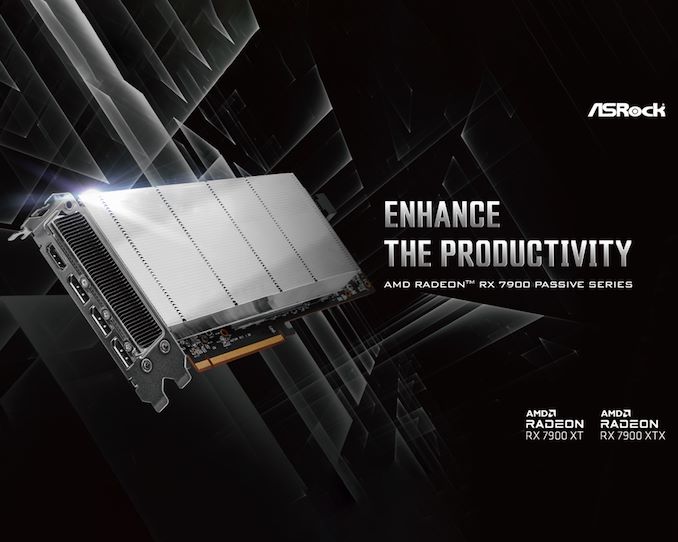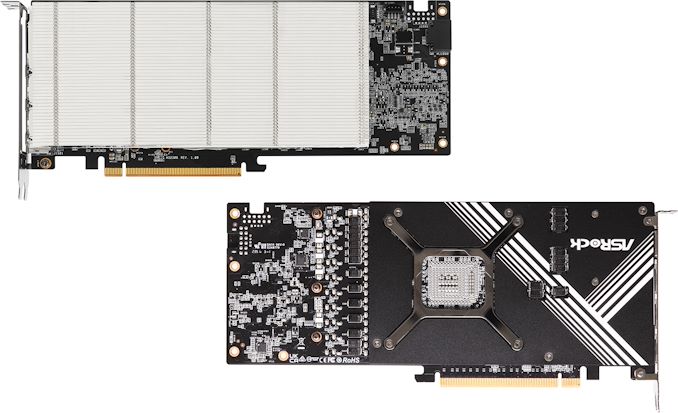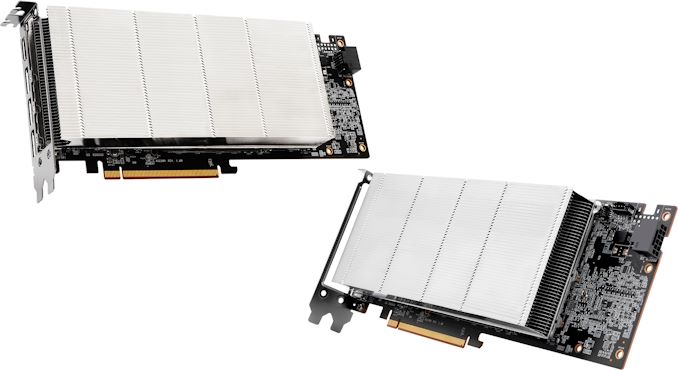ASRock Launches Passively Cooled Radeon RX 7900 XTX & XT Cards for Servers
by Anton Shilov on July 26, 2024 4:00 PM EST- Posted in
- GPUs
- AMD
- ASRock
- Passive Cooling
- Navi 31
- Radeon RX 7900

As sales of GPU-based AI accelerators remain as strong as ever, the immense demand for these cards has led to some server builders going off the beaten path in order to get the hardware they want at a lower price. While both NVIDIA and AMD offer official card configurations for servers, the correspondingly high price of these cards makes them a significant financial outlay that some customers either can't afford, or don't want to pay.
Instead, these groups have been turning to buying up consumer graphics cards, which although they come with additional limitations, are also a fraction of the cost of a "proper" server card. And this week, ASRock has removed another one of those limitations for would-be AMD Radeon users, with the introduction of a set of compact, passively-cooled Radeon RX 7900 XTX and RX 7900 XT video cards that are designed to go in servers.
Without any doubts, ASRock's AMD Radeon RX 7900 XTX Passive 24GB and AMD Radeon RX 7900 XT Passive 20GB AIBs are indeed graphics cards with four display outputs and based on the Navi 31 graphics processor (with 6144 and 5376 stream processors, respectively), so they can output graphics and work both with games and professional applications. And with TGPs of 355W and 315W respectively, these cards aren't underclocked in any way compared to traditional desktop cards. However, unlike a typical desktop card, the cooler on these cards is a dual-slot heatsink without any kind of fan attached, which is meant to be used with high-airflow forced-air cooling.
All-told, ASRock's passive cooler is pretty capable, as well; it's not just a simple aluminum heatsink. Beneath the fins, ASRock has gone with a vapor chamber and multiple heat pipes to distribute heat to the rest of the sink. Even with forced-air cooling in racked servers, the heatsink itself still needs to be efficient to keep a 300W+ card cool with only a dual-slot cooler – and especially so when upwards of four of these cards are installed side-by-side with each other. To make the boards even more server friendly, these cards are equipped with a 12V-2×6 power connector, a first for the Radeon RX 7900 series, simplifying installation by reducing cable clutter.
Driving the demand for these cards in particular is their memory configuration. With 24GB for the 7900 XTX and 20GB for the 7900 XT is half as much (or less) memory than can be found on AMD and NVIDIA's high-end professional and server cards, AMD is the only vendor offering consumer cards with this much memory for less than $1000. So for a memory-intensive AI inference cluster built on a low budget, the cheapest 24GB card available starts looking like a tantalizing option.
Otherwise, ASRock's Radeon RX 7900 Passive cards distinguish themselves from AMD's formal professional and server cards by what they're not capable of doing: namely, remote professional graphics or other applications that need things like GPU partitioning. These parts look to be aimed at one application only, artificial intelligence, and are meant to process huge amounts of data. For this purpose, their passive coolers will do the job and the lack of ProViz or VDI-oriented drives ensure that AMD will leave these lucrative markets for itself.
Source: ASRock












8 Comments
View All Comments
Scott_T - Friday, July 26, 2024 - link
passive as long as you dont count all the fans a server has pushing air through them.Oxford Guy - Friday, July 26, 2024 - link
Exactly. Calling this passive in a bit of a stretch.ballsystemlord - Friday, July 26, 2024 - link
I agree. These are passive in name only.Khanan - Saturday, July 27, 2024 - link
Huge blunder by the Author.PeachNCream - Saturday, July 27, 2024 - link
You must be new here. Welcome to Anandtech Pipeline News!Joking aside, it's clearly stated in the article text that the card requires a server's airflow and though the title is misleading and a structured to act as clickbait, the body is relatively well-written for once.
Ryan Smith - Saturday, July 27, 2024 - link
The author did nothing wrong.The industry nomenclature for a card/accelerator without a fan to create its own airflow (i.e. active) is that it's a passive card.
It's not a particularly good definition, since it overlaps with convection-cooled cards, but it is what it is.
Oxford Guy - Saturday, July 27, 2024 - link
Industry standards are malleable, as with how Samsung chose to (deceptively) market TLC and QLC products as 'MLC.'That's an example of terminology being abused as a regression from the preceding norm. Terminology that conflates convention-based cooling with extreme-noise server room airflow is an example of poor terminology in need of a change. How many things in tech have a larger conceptual gap than passive cooling versus server room fan-based cooling?
It's over the top to chastise the author for a 'huge blunder' but it's also overstatement to say that there's nothing wrong in using terminology that is known to be misleading simply because it is currently popular.
Khanan - Saturday, July 27, 2024 - link
I meant the author of the source article. It’s also a joke based on BBT (Steven Hawking)